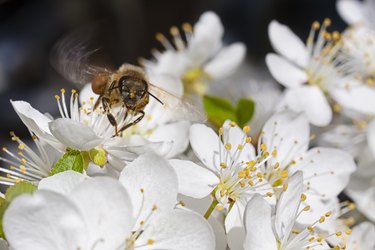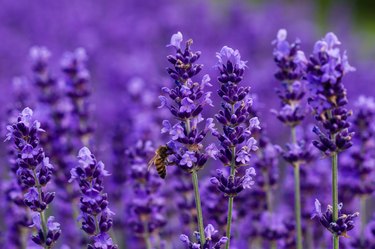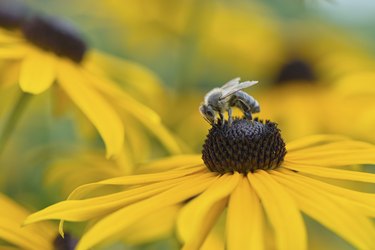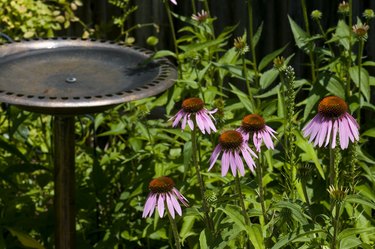
Bees and flowers have mutually beneficial relationships. Flowers provide nectar or pollen bees need, and bee pollination helps flowers produce fruit and seeds. Wind plays a role in pollinating some plants, but many garden blooms depend exclusively on bees.
Nonnative bees, such as honeybees, are important pollinators, but native bees in all shapes and sizes play vital roles. Different bee species have distinct flower preferences, but some features attract all types of bees. By planting flowers with one or many of these qualities, you support bees and boost your garden's productivity.
Video of the Day
Video of the Day
Flower Color and Fragrance

Bees prefer brightly colored flowers -- especially yellow, white and purple-blue. Some flowers, including native black-eyed Susans (Rudbeckia fulgida, hardy in U.S. Department of Agriculture plant hardiness zones 3 through 9), also offer ultraviolet markings -- invisible to humans -- that point to nectar. Masses of single color against contrasting colors attracts bees, too.
Just as appealing floral fragrances attract people, pleasing scents attract bees. Many modern plants, bred for beauty and form, have little fragrance. Old-fashioned heirlooms, such as "Frau Dagmar Hastrup" rose (Rosa "Frau Dagmar Hastrup, USDA zones 3 through 9), delight bees with extremely fragrant blooms.
Aromatic waves of blue lavender (Lavandula spp., USDA zones 4 through 9) invite steady streams of bees, as do golden-yellow, annual pot marigolds (Calendula officinalis) and white Shasta daisies (Leucanthemum x superbum, USDA zones 4 through 9).
Bloom Size and Shape

Some bees specialize in flower types, while others visit all blooms. Anatomy influences flowers' preferences. Some bees, including honeybees and native bumblebees, access nectar with long tongues, but other bees have short tongues. Flat, shallow blossoms simplify nectar sipping for long- and short-tongued bees.
Aster family (Asteraceae) members, such as annual sunflower (Helianthus annuus) and purple coneflower (Echinacea purpurea, USDA zones 3 through 8) provide easy landing and open faces for all bees -- along with abundant nectar and pollen.
Long-tongued bees also frequent plants with tubular blooms, such as beardtongue (Penstemon spp., USDA zones 3 through 10) and foxglove (Digitalis spp., USDA 3 through 9).
Nectar Production

Nectar provides foraging bees with food in the form of sugar, essential amino acids and needed moisture. Bees generally seek more nectar than pollen, so blocks of nectar-rich flowers keep bees content. Less travel between blooms means less energy expended.
Many culinary and ornamental herbs in the mint family (Lamiaceae), often grown as annuals, produce large amounts of floral nectar compared to other blooming plants. Characteristic squared stems -- and busy bees -- identify these flowers, including bee balm (Monarda didyma, USDA zones 4 through 9), lemon balm (Melissa officinalis, USDA zones 3 through 7), rosemary (Rosmarinus officinalis cvs., USDA zones 7 through 10) and catmint (Nepeta × faassenii, USDA zones 3 through 8).
Pollen Presentation

Bees gather pollen -- seen as orange-yellow saddle bags on their hind legs -- for the next bee generation. Pollen provides high-protein nutrition for bee offspring. Some flowers produce light pollen that floats on air. In others, it's dense and sticky. Without bee help, pollination would not occur.
Bees target some flowers, such as California poppy (Eschscholzia californica, USDA zone 6 through 10), strictly for their nectarless, pollen-rich blooms.
Annual vegetable flowers in the potato family (Solanaceae) produce only pollen -- no nectar. These include tomatoes (Lycopersicon esculentum), potatoes (Solanum tuberosum), eggplants (Solanum melongena) and peppers (Capsicum spp.). These flowers require a special vibrating technique known as buzz pollination. Bumblebees are experts; honeybees can't do it. Grouping these pollen-heavy flowers attracts bees and gets vegetables pollinated.
Seasons of Bloom

Nonnative honeybees forage year-round when climate allows it. Bumblebees feed from late winter until late fall. (Ref. 4-pg. 8) Both bees are generalists, visiting all flower types. Continual, changing blooms keep them active and happy.
Other types of native bees have specific, limited seasons. Adult bees are only active a few weeks each year. These active times vary by species. Bees that visit your garden in early spring differ from those that seek your blooms in fall.
Native plants local to your growing region adapted alongside your region's native bees. Their blooms coincide with specific native bees that trade specialized pollination for nectar and pollen. Locally native flowers draw locally native bees and help ensure both continue for future generations.
Surrounding Habitat

Flowers aren't all that attract bees to gardens. Inviting habitats increase bee visits. Honeybees need water, in addition to pollen and nectar. A birdbath or shallow water dish welcomes them. Flowers of varying heights provide bees with shelter, as do bee houses or small, strategic twig piles.
Honeybees and bumblebees are social, colony-forming bees, but most natives are solitary. Many dwell underground and need mulch-free soil to make their homes.
Keep your garden bee-friendly, and restrict pesticide use. Most plants bloom and produce nectar during daytime hours; bee activity follows suit. If chemicals are used, limit them to evening hours when bees aren't active. Always keep chemicals away from open blooms.
- University of California Agriculture and Natural Resources: How to Attract and Maintain Pollinators in Your Garden
- UC Berkeley Urban Bee Lab
- USDA Forest Service and Pollinator Partnership: Bee Basics -- An Introduction to Our Native Bees
- Pollinator Partnership and North American Pollinator Protection Campaign: Selecting Plants for Pollinators
- BeeSpotter: Making a Bee-Friendly Garden
- Rose of Yesterday and Today: Our Roses
- Missouri Botanical Garden: Plant Finder
- Pollinator Partnership: Free Pollinator Friendly Planting Guides
- The Xerces Society for Invertebrate Conservation: Pollinator Conservation Resource Center